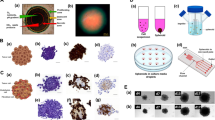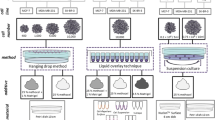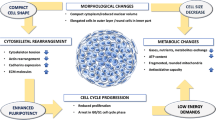Summary
The cancer stem cells (CSCs) from human osteosarcoma by serum-free three-dimensional culture combined with anticancer drugs were isolated and identified. The primary cells derived from human osteosarcoma were digested by trypsin to prepare a single-cell suspension, and mixed homogeneously into 1.2% alginate gel. Single-cell alginate gel was cultured with serum-free DMEM/F12 medium. Epirubicin (0.8 μg/mL) was added to the medium to enrich CSCs. After cultured conventionally for 7 to 10 days, most of cells suspended in alginate gel were killed by epirubicin. But few cells survived and some single-cell cloning spheres formed. Immunofluorescent staining for Oct3/4 and Nanog was implemented to find cells with properties of self-renewal and multi-potential differentiation. Cells from cloning spheres were transplanted into BALB/c mice to detect the tumorigenicity in vivo. The results showed that some cells positive for Oct3/4 (TRITC) and Nanog (TRITC) were found in single-cell cloning spheres, and most of positive cells were concentrated in the core of sphere. Cells from spheres could form osteosarcoma in the body of mice. It was concluded that cells from single-cell cloning spheres had the properties of the expression of parts of stem cell genes (Oct3/4 and Nanog), resisting anti-cancer drugs, and tumorigenicity in vivo. To sum up, it is believed that cells obtained from osteosarcoma by serum-free three-dimensional culture combined with anticancer drugs are cancer stem cells.
Similar content being viewed by others
References
Gatta G, Capocaccia R, Stiller C, et al. Childhood cancer survival trends in Europe: a EUROCARE Working Group study. J Clin Oncol, 2005,23(16):3742–3751
Meyers PA, Schwartz CL, Krailo M, et al. Osteosarcoma: a randomized, prospective trial of the addition of ifosfamide and/or muramyl tripeptide to cisplatin, doxorubicin, and high-dose methotrexate. J Clin Oncol, 2005,23(9):2004–2011
Reya T, Morrison SJ, Clarke MF, et al. Stem cells, cancer, and cancer stem cells. Nature, 2001,414(6859):105–111
Marx J. Mutant stem cells may seed cancer. Science, 2003,301(5638):1308–1310
Al-Hajj M, Wicha MS, Benito-Hernandez A, et al. Prospective identification of tumorigenic breast cancer cells. Proc Natl Acad Sci USA, 2003,100:3983–3988
Galli R, Binda E, Orfanelli U, et al. Isolation and characterization of tumorigenic, stem-like neural precursors from human glioblastoma. Cancer Res, 2004,64(19): 7011–7021
Collins AT, Berry PA, Hyde C, et al. Prospective identification of tumorigenic prostate cancer stem cells. Cancer Res, 2005,65(23):10 946–10 951
Kim CF, Jackson EL, Woolfenden AE, et al. Identification of bronchioalveolar stem cells in normal lung and lung cancer. Cell, 121(6):823–835
Ricci-Vitiani L, Lombardi DG, Pilozzi E, et al. Identification and expansion of human colon-cancer-initiating cells. Nature, 2007,445(7123):111–115
Yin S, Li J, Hu C, et al. CD133 positive hepatocellular carcinoma cells possess high capacity for tumorigenicity. Int J Cancer, 2007,120(7):1444–1450
Yang ZF, Ngai P, Ho DW, et al. Identification of local and circulating cancer stem cells in human liver cancer. Hepatology, 2008,47(3):919–928
Woodward WA, Sulman EP. Cancer stem cells: markers or biomarkers? Cancer Metastasis Rev. 2008, 27(3):459–470
Phillips TM, McBride WH, Pajonk F. The response of CD24 (/low)/CD44+ breast cancer-initiating cells to radiation. J Natl Cancer Inst, 2006,98(24):1777–1785
Inagaki A, Soeda A, Oka N, et al. Long-term maintenance of brain tumor stem cell properties under at non-adherent and adherent culture conditions. Biochem Biophys Res Commun, 2007,361(3):586–592
Sutherland RM. Cell and environment interactions in tumor microregions: the multicell spheroid model. Science, 1988,240(4849):177–184
Kelm JM, Kramer BP, Gonzalez-Nicolini V, et al. Method for generation of homogeneous multicellular tumor spheroids applicable to a wide variety of cell types. Biotechnol Bioeng, 2003,83(2):173–180
Fischbach C, Chen R, Matsumoto T, et al. Engineering tumors with 3D scaffolds. Nat Methods, 2007,4(10):855–860
Jeon O, Bouhadir KH, Mansour JM, et al. Photocrosslinked alginate hydrogels with tunable biodegradation rates and mechanical properties. Biomaterials, 2009,30(14):2724–2734
de Vos P, Faas MM, Strand B, et al. Alginate-based microcapsules for immunoisolation of pancreatic islets. Biomaterials, 2006,27(32):5603–5617
West ER, Xu M, Woodruff TK, et al. Physical properties of alginate hydrogels and their effects on in vitro follicle development. Biomaterials, 2007,28(30):4439–4448
Markusen JF, Mason C, Hull DA, et al. Behavior of adult human mesenchymal stem cells entrapped in alginate-GRGDY beads. Tissue Eng, 2006,12(4):821–830
Sagar J, Chaib B, Sales K, et al. Role of stem cells in cancer therapy and cancer stem cells: a review. Cancer Cell Int, 2007,7:9
Toda S, Watanabe K, Yokoi F, et al. A new organotypic culture of thyroid tissue maintains three-dimensional follicles with C cells for a long term. Biochem Biophys Res Commun, 2002,294(4):906–911
Nichols J, Zevnik B, Anastassiadis K, et al. Formation of pluripotent stem cells in the mammalian embryo depends on the POU transcription factor Oct-4. Cell, 1998,95(3): 379–391
Hoei-Hansen CE, Almstrup K, Nielsen JE, et al. Stem cell pluripotency factor Nanog is expressed in human fetal gonocytes, testicular carcinoma in situ and germ cell tumours. Histopathology, 2005,47(1):48–56
Yuan X, Curtin J, Xiong Y, et al. Isolation of cancer stem cells from adult glioblastoma multiforme. Oncogene, 2004,23(58):9392–9400
Singh SK, Clarke ID, Terasaki M, et al. Identification of a cancer stem cell in human brain tumors. Cancer Res, 2003,63(18):5821–5828
Kondo T, Setoguchi T, Taga T. Persistence of a small subpopulation of cancer stem-like cells in the C6 glioma cell line. Proc Natl Acad Sci USA, 2004,101(3):781–786
Author information
Authors and Affiliations
Corresponding author
Rights and permissions
About this article
Cite this article
Zhou, S., Li, F., Xiao, J. et al. Isolation and identification of cancer stem cells from human osteosarcom by serum-free three-dimensional culture combined with anticancer drugs. J. Huazhong Univ. Sci. Technol. [Med. Sci.] 30, 81–84 (2010). https://doi.org/10.1007/s11596-010-0114-4
Received:
Published:
Issue Date:
DOI: https://doi.org/10.1007/s11596-010-0114-4




